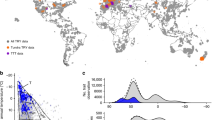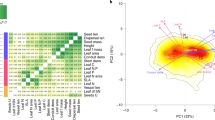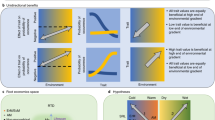Abstract
Linking functional traits to plant growth is critical for scaling attributes of organisms to the dynamics of ecosystems1,2 and for understanding how selection shapes integrated botanical phenotypes3. However, a general mechanistic theory showing how traits specifically influence carbon and biomass flux within and across plants is needed. Building on foundational work on relative growth rate4,5,6, recent work on functional trait spectra7,8,9, and metabolic scaling theory10,11, here we derive a generalized trait-based model of plant growth. In agreement with a wide variety of empirical data, our model uniquely predicts how key functional traits interact to regulate variation in relative growth rate, the allometric growth normalizations for both angiosperms and gymnosperms, and the quantitative form of several functional trait spectra relationships. The model also provides a general quantitative framework to incorporate additional leaf-level trait scaling relationships7,8 and hence to unite functional trait spectra with theories of relative growth rate, and metabolic scaling. We apply the model to calculate carbon use efficiency. This often ignored trait, which may influence variation in relative growth rate, appears to vary directionally across geographic gradients. Together, our results show how both quantitative plant traits and the geometry of vascular transport networks can be merged into a common scaling theory. Our model provides a framework for predicting not only how traits covary within an integrated allometric phenotype but also how trait variation mechanistically influences plant growth and carbon flux within and across diverse ecosystems.
This is a preview of subscription content, access via your institution
Access options
Subscribe to this journal
Receive 51 print issues and online access
$199.00 per year
only $3.90 per issue
Buy this article
- Purchase on Springer Link
- Instant access to full article PDF
Prices may be subject to local taxes which are calculated during checkout



Similar content being viewed by others
References
Diaz, S. & Cabido, M. Plant functional types and ecosystem function in relation to global change. J. Veg. Sci. 8, 463–474 (1997)
Lavorel, S. & Garnier, E. Predicting changes in community composition and ecosystem functioning from plant traits: revisiting the Holy Grail. Funct. Ecol. 16, 545–556 (2002)
Reich, P. B. et al. The evolution of plant functional variation: Traits, spectra, and strategies. Int. J. Plant Sci. 164, S143–S164 (2003)
Hunt, R. Plant Growth Analysis (Edward Arnold Limited, London, 1978)
Poorter, H. in Variation in Growth Rate and Productivity of Higher Plants (eds Lambers, H., Cambridge, M. L., Konings, H. & Pons, T. L.) 45–68 (SPB Academic Publishing, The Hague, 1989)
Grime, J. P. & Hunt, R. Relatve growth-rate: its range and adaptive significance in a local flora. J. Ecol. 63, 393–422 (1975)
Reich, P. B., Walters, M. B. & Ellsworth, D. S. From tropics to tundra: global convergence in plant functioning. Proc. Natl Acad. Sci. USA 94, 13730–13734 (1997)
Wright, I. J. et al. The worldwide leaf economics spectrum. Nature 428, 821–827 (2004)
Wright, I. J. et al. Relationships among major dimensions of plant trait variation in 7 neotropical forests. Ann. Bot. Lond. doi: 10.1093/aob/mcl066 (2006)
West, G. B., Brown, J. H. & Enquist, B. J. A general model for the structure and allometry of plant vascular systems. Nature 400, 664–667 (1999)
Enquist, B. J., West, G. B., Charnov, E. L. & Brown, J. H. Allometric scaling of production and life-history variation in vascular plants. Nature 401, 907–911 (1999)
McGill, B., Enquist, B. J., Weiher, E. & Westoby, M. Rebuilding community ecology from functional traits. Trends Ecol. Evol. 21, 178–185 (2006)
Westoby, M., Falster, D. S., Moles, A. T., Vesk, P. A. & Wright, I. J. Plant ecological strategies: some leading dimensions of variation between species. Annu. Rev. Ecol. Syst. 33, 125–159 (2002)
Field, C. & Mooney, H. A. in On the Economy of Plant Form and Function (ed. Givnish, T. J.) 25–55 (Cambridge Univ. Press, Cambridge, UK, 1986)
Pickup, M., Westoby, M. & Basden, A. Dry mass costs of deploying leaf area in relation to leaf size. Funct. Ecol. 19, 88–97 (2005)
Konings, H. in Variation in Growth Rate and Productivity of Higher Plants (eds Lambers, H., Cambridge, M. L., Konings, H. & Pons, T. L.) 101–123 (SPB Academic Publishing, The Hague, 1989)
Santiago, L. S. et al. Leaf photosynthetic traits scale with hydraulic conductivity and wood density in Panamanian forest canopy trees. Oecologia 140, 543–550 (2004)
Bonser, S. P. Form defining function: interpreting leaf functional variability in integrated plant phenotypes. Oikos 114, 187–190 (2006)
Shipley, B., Lechowicz, M. J., Wright, I. & Reich, P. B. Fundamental trade-offs generating the worldwide leaf economics spectrum. Ecology 87, 535–541 (2006)
Niklas, K. J. & Enquist, B. J. Invariant scaling relationships for interspecific plant biomass production rates and body size. Proc. Natl Acad. Sci. USA 98, 2922–2927 (2001)
Lambers, H., Freijsen, N., Poorter, H., Hirose, T. & van der Werff, H. in Variation in Growth Rate and Productivity of Higher Plants (eds Lambers, H., Cambridge, M. L., Konings, H. & Pons, T. L.) 1–17 (SPB Academic Publishing, The Hague, 1989)
Gifford, R. M. Plant respiration in productivity models: conceptualisation, representation and issues for global terrestrial carbon-cycle research. Funct. Plant Biol. 30, 171–186 (2003)
Enquist, B. J. et al. Biological scaling: Does the exception prove the rule? Nature 445, E9–E10 (2007)
Tilman, D. Plant Strategies and the Dynamics and Structure of Plant Communities (Princeton Univ. Press, Princeton, 1988)
Waring, R. H., Landsberg, J. J. & Williams, M. Net primary production of forests: a constant fraction of gross primary production? Tree Physiol. 18, 129–134 (1998)
Chambers, J. C. et al. Respiration from a tropical forest ecosystem: Partitioning of sources and low carbon use efficiency. Ecol. Appl. 14, S72–S88 (2004)
Enquist, B. J., Kerkhoff, A. J., Huxman, T. E. & Economo, E. P. Adaptive differences in plant physiology and ecosystem invariants: insights from a metabolic scaling model. Glob. Change Biol. 13, 591–609 (2007)
Kerkhoff, A. J., Enquist, B. J., Elser, J. J. & Fagan, W. F. Plant allometry, stoichiometry and the temperature-dependence of primary productivity. Glob. Ecol. Biogeogr. 14, 585–598 (2005)
Arnold, A. E. & Lutzoni, F. Diversity and host range of foliar endophytes: Are tropical leaves biodiversity hotspots? Ecology 88, 541–549 (2007)
Price, C. A., Enquist, B. J. & Savage, V. M. A general model for allometric covariation in botanical form and function. Proc. Natl Acad. Sci. USA 104, 13204–13209 (2007)
Acknowledgements
We especially thank J. Stegen for assistance with data and comments. We also thank S. R. Saleska, T. Huxman, A. Angert, A. E. B. Arnold, J. Pither, C. Lamanna and P. Chesson for comments and suggestions on earlier drafts. I. J. Wright provided constructive comments. B.J.E., A.J.K., C.A.P. and N.G.S. were supported by a NSF Career Award (to B.J.E.). A.J.K. was also supported by an HHMI Undergraduate Science Education Program Award to Kenyon College and N.G.S. was supported by a USGS fellowship. M.C.M. and S.C.S. were supported by an NSF predoctoral award. I. J. Wright and M. Pickup shared data sets. In addition, we acknowledge the use of GLOPNET data in some of our analyses.
Author Contributions B.J.E. designed the study. B.J.E., A.J.K. and S.C.S. developed the theory, compiled and analysed data, and wrote the paper. N.G.S., M.C.M. and C.A.P. provided data, ideas and comments on manuscript drafts.
Author information
Authors and Affiliations
Ethics declarations
Competing interests
Reprints and permissions information is available at www.nature.com/reprints. The authors declare no competing financial interests.
Supplementary information
Supplementary Information
This file contains Supplementary Discussion and Equations, Supplementary Methods, Supplementary Figures S1-S4 (Graphs), Supplementary Tables S1-S2 and additional references. (PDF 7730 kb)
Supplementary Data
This file contains the original data which supports Supplementary Table S1 in file s1. Please note that this file was originally omitted and was uploaded on April 2nd, 2009. (XLS 194 kb)
Rights and permissions
About this article
Cite this article
Enquist, B., Kerkhoff, A., Stark, S. et al. A general integrative model for scaling plant growth, carbon flux, and functional trait spectra. Nature 449, 218–222 (2007). https://doi.org/10.1038/nature06061
Received:
Accepted:
Published:
Issue Date:
DOI: https://doi.org/10.1038/nature06061
This article is cited by
-
Trait-mediated processes and per capita contributions to ecosystem functioning depend on conspecific density and climate conditions
Communications Earth & Environment (2024)
-
Functional traits and habitat heterogeneity explain tree growth in a warm temperate forest
Oecologia (2023)
-
Intraspecific trait variation and coordination of leaf economics spectrum in Elaeagnus angustifolia across three basins in Central Asia
Plant Ecology (2023)
-
Divergence in functional traits in seven species of neotropical palms of different forest strata
Oecologia (2023)
-
Leaf water content contributes to global leaf trait relationships
Nature Communications (2022)
Comments
By submitting a comment you agree to abide by our Terms and Community Guidelines. If you find something abusive or that does not comply with our terms or guidelines please flag it as inappropriate.



